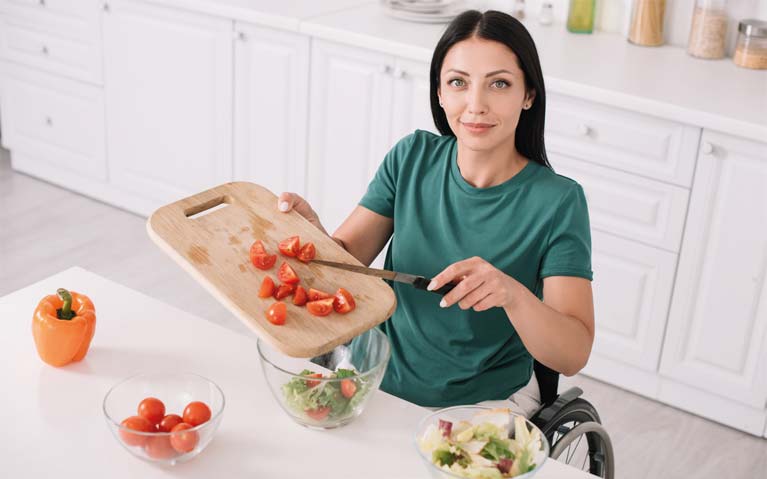
There is more to life than our shape and size and how you feel about your quality of life is arguably what matters the most. Some people with a spinal cord injury find they lose a lot of their muscle strength but also a significant proportion of their internal energy stores of fat, which can be part of being less mobile but also not feeling as hungry or able to eat in the same way as before. Others find their muscle mass decreases but as they are less mobile, and their hunger is the same or higher, they find their internal energy stores increase even if they have not changed how they eat or drink. Both of these scenarios can make it feel more tiring to be as physically independent as you’d like, make you more prone to developing diabetes but also put extra pressure on your joints and skin that can cause pressure ulcers.
Ultimately, every individual wants to be as healthy and happy for as long as possible and you can use nutrition to help.

When we eat and drink, we consume much needed nutrients like fat, protein and carbohydrate that provide energy that is needed to power our bodies, plus vitamins and minerals that are essential for functions like having an efficient immune system. Everybody has some internal energy stores because they help protect our organs and keep us warm; how much energy we consume can help us increase or decrease them. Whether you are looking to maintain your shape or size, or increase or decrease your internal energy stores, it’s always important to eat a variety of foods to get enough nutrients so you can stay well and do the activities you enjoy.
Our top spinal cord injury diet tips
No matter what you are hoping to achieve, find recipes you love so you can include a variety of foods and make them taste great. Food is as much about enjoyment as it is nourishment and taking pleasure in what we eat can help us feel more satisfied, along with boosting our mood and mental health.
Muscle gain after spinal cord injury
1. If you get full easily and cannot finish meals, consider having drinks after eating or about 15-30 minutes before starting to eat so the drinks do not reduce your appetite.
2. Aim for each third of your plate as below, and if you cannot finish all on your plate prioritise these foods in this order:
- A high-protein food like meat, poultry, fish, eggs, tofu, lentils etc
- Starchy carbohydrates such as rice or potatoes
- Some fruits and vegetables e.g. broccoli, carrots, tomatoes
3. Swap products labelled as ‘low fat’ for natural and minimally processed fats. Include a serving of natural fat with each meal such as a drizzle of olive oil, a tablespoon of butter, a sprinkle of cheese, nuts, or seeds.
4. You might find it easier to eat 4-6 small meals or large snacks instead of 3 main meals. ‘Complete’ or ‘A-Z’ multivitamin and mineral supplements do not replace a well-balanced way of eating and drinking, but they can help in some circumstances so reach out to your Doctor if you think these may benefit you and do not counteract any other medical advice you’re following.
Weight loss after spinal cord injury
1. Being hydrated helps our body tell the difference between hunger and thirst, plus drinking enough with meals and between them can help us feel fuller and more satisfied from our meals. We have shared a few suggestions in our other sections, but our separate ‘Living with a Urinary Catheter Hydration Guide’ is full of ideas to help you drink enough throughout the day.
2. Aim for 3 well-balanced meals a day rather than snacking or grazing because otherwise it can be easy to overeat. Having occasional foods such as crisps, chocolate etc, but also nutritious snacks like yoghurt and berries, is unlikely to counteract all your other healthy habits and can be part of eating being flexible, enjoyable, and ultimately sustainable. However, if you are frequently snacking then it potentially can hold you back from reaching your personal health goals. Whatever you eat, take your time, and savor each mouthful so you find more pleasure when eating and are more satisfied from a smaller or regular portion size.
3. Try adjusting your meal proportions help keep you fuller for longer:
- Half your plate as vegetables e.g. broccoli, carrots, tomatoes
- A quarter of your plate as a high protein food like meat, poultry, fish, eggs, tofu, lentils etc
- A quarter of your plate as starchy carbohydrates such as rice or potatoes
4. Choose more homemade meals or minimally processed options as these will be more nutritious to help with your skin, bone, and overall health, plus will often be more filling and satisfying. There are lots of great recipes available in various cookbooks and for free online on many websites. There are also ‘homemade-takeaway’ recipes you can find such as for curries, pizza, and other dishes.
